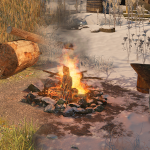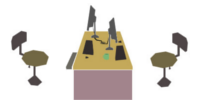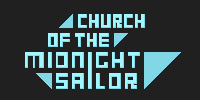Interview: The End of the Sun’s Jakub Machowski
A Slavic fantasy game blending time-control mechanics and the peasant experience, The End of the Sun spans seasons and lives, telling the stories of characters at different critical moments as the protagonist chases an elusive foe. I chatted with Jakub Machowski on the nature of his work, which has been especially busy of late, given the current Kickstarter campaign.
Erik Meyer: The End of the Sun presents a mystery by way of riddles and four festivals taking place during 4 seasons spread out over many years. In adventure games, I’ve often found that the setting feels like a character in and of itself; would you agree with that assessment in your work? And as you’ve built stories in various locations, how do you see the where influencing the who and the what?
Jakub Machowski: Per the influence of the game world on in-game characters, you are totally right. Firstly, we created the world; then we put characters into it, and the elements of the world influence central character elements. For example, if our characters live in a village far away from a big town, distance means they are often away from home selling their wares. So this influences the overall relationships of characters, etc. 🙂 If you are asking about our world design overall, the setting will influence the emotions and thoughts of the player on its own; game design was really hard to prepare in our game, because we would like it to not only influence the player but sometimes provide relaxing atmosphere and add a darker climate (by the way, this kind of amplitude between sadness and happiness is something what is strongly characteristic of Slav culture). In conjunction with time travel, these elements were challenging when developing the world 🙂
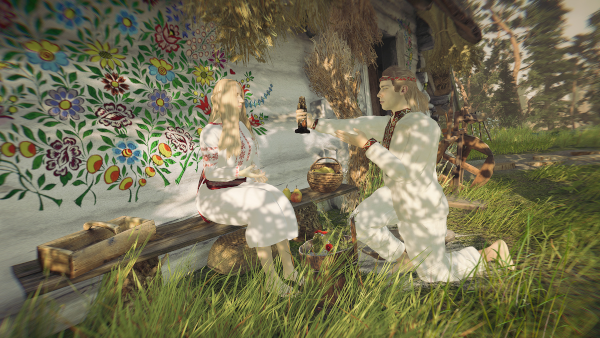
EM: The line between myth and reality blurs in the traditions of most cultures; from a dev point of view, I’m curious about your process of balancing and integrating. How far feels too far, and how do you avoid a scene feeling too fantastic? Similarly, what metric helps an area from feeling too mundane?
JM: Good question. Overall, as you mention, we always stress that our game is not a historical game but falls within fantasy. We are highly inspired not by historical events, but by a culture that is still alive and well (even with small changes, such as a Christmas tree that doesn’t come from christian culture but from many pagans; we also incorporate the Slavic tradition of celebrating the shortest night of the year because it connects to beginnings and the universal observations that people did in olden times). When creating scenes and locations, we need to feel like that character, and we are trying to incorporate elements that everyone knows from physics into our game as magic. Even when making a fantasy game, you have to strongly stay grounded on earth. Magic can’t be explained as just magic. You could explain to players why our Ashter can manipulate time, and to be honest, the player isn’t sure if this is happening only in the Ashter’s mind as a vision, or for real. About that, I can’t say more for now. But looking at our world, if someone tells you he saw a ghost, you can’t say it is true or not true, because this is his subjective opinion. You could only say that other people didn’t see that ghost, so it isn’t real. But this is still not 100%; this is only other opinions. This is what we are trying to do. 1. When making magic, try to keep within the bounds of physics 2. Explain that some people feel things differently than others. This is the main element of Slavic culture that we would like to display. Slavs have a strong connection and a feeling of natural powers; they believed everything was connected within nature and that the gods of other cultures were as real as their own gods. We spent more than half a year on the script, and it probably still needs some polishing 🙂
EM: Obviously, Slavic culture and legends play a huge role in the visual, audio, and content focus of the game experience. You even went to far as to scan ethnographic museums via photogrammetry, a process that brings both historical accuracy and a lived-in feel. I’ve played a lot of titles that stray from the original subject matter, so what drove this connection to real places and heritage, and how did you balance fiction with nonfiction?
JM: Overall, scanned elements provide details that we probably wouldn’t even think about when making 3d models manually. It helps a lot in the creation of a reliable world. Basically, in out game, we don’t use real objects as fantasy objects with ultra-magic properties 🙂 In Slavic culture, it’s less to do with magic swords or boxes but rather focuses on people who have possibilities (sometimes modified by nature). You could see that in the Witcher game that was highly inspired by Slavic mythology. Witchers were modified by herbs etc., making them stronger. Also, magic in Slavic mythology and culture is highly related more to alchemy than pure magic, and gets used wisely.
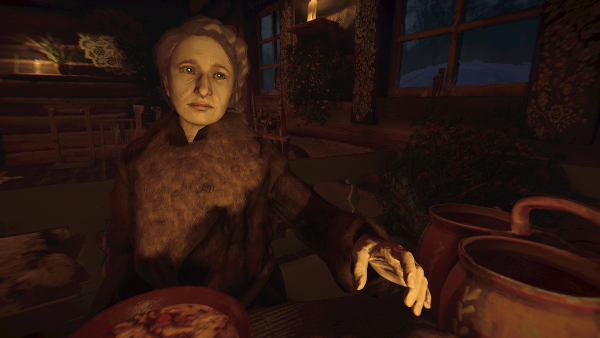
EM: The mechanic by which time can cycle forward and backwards reminds me a bit of Tacoma’s method of reviewing logs on a derelict ship; what was the spark that got you using this specific method of interaction, and how does it change the way in which you tell stories?
JM: This is interesting, because it affects design a lot. We didn’t expect that it would influence it so much, and we had to spend a lot more time on script and game design as a result. Overall, this is difficult, because we have 4 seasons that we travel between, so home interiors and environments need to be designed 4 times. For example, there will be in-game situations with a burned building. To clarify, after you unlock a summer event, characters will burn the building, and in autumn, the building will be burnt, as well. That means that we need to have 2 designs of the same building for autumn, one not affected by the earlier event and the other affected. Also worth mentioning: we are focused mostly on characters who then effect events, not only on the events themselves; that stands as a very important point for our game. It seems to be the same but provides much more interesting gameplay 🙂 Also, there is always a lot of anticipating what exactly happened and what not; for example, prior to events, we don’t exactly know how they’ll influence the final story; we only learn afterwards. Seems complicated, but it is fun during gameplay 🙂
EM: There’s something about artifacts from centuries past that captivates, whether it’s processing grain or churning butter. Do you see simple physical actions as linked to an instinctive hands-on human drive to stay busy, or is it something closer to shiny object syndrome?
JM: Personally, I think we love connecting to historical activities because it is our longing for days when people had time to unite with nature and do simple things, and were free from constantly looking for money. Back then, people were living. This is what many people today miss, because it’s so hard to achieve now – live, not only exist 🙂 So maybe it is longing for moments where our brains are free from too many thoughts. Just our personal opinion. But this is another thing that we would like to achieve in the game; it becomes a place where you can just relax and observe your surroundings for a moment to see how fascinating the cycle of nature is and how fast it is changing 🙂 For people who like to relax in this way, it will be a game they will probably play through a few times, just to watch how summer changes to autumn and to winter and again to spring.
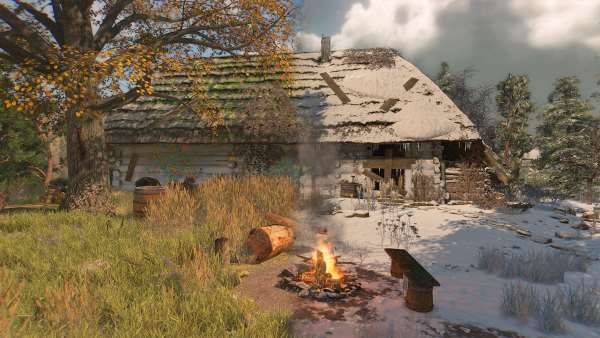
EM: TEOTS immediately comes across as a very personal world, a world in which everything has been carefully placed in the setting to create a homespun atmosphere. At a time when so many games use procedural generation, what is it about making a location smaller and more intentional that can make it so meaningful?
JM: Bigger, as you noticed, doesn’t always mean better. Nowadays, the size of a world and the time of play make for good marketing. We are focusing on quality and emotions; we are an indie studio and hopefully – because of Kickstarter – we will be able to stay indie 🙂 Our world is not huge, but it is multiplied by 4 as I mentioned before. In a small location, there is no single meaningful question; everything is important, but for sure design needs to be done in a way that helps you uncover atypical experiences in peaceful places. Something that preserves mystery. For example, put a few buckets of water near a well – that’s normal for people, but take the same buckets and put them in the middle of the road – now an interesting story emerges and the audience wonders why there are here 🙂
EM: You previously worked on The Mims Beginning, which constitutes a very different style of game; as a dev, what big takeaways do you glean from earlier projects, and what parts of the process does experience speed up the most?
JM: During The Mims Beginning’s development, I learned an enormous number of things and increased my experience 1000%. Now, we have two people working in the same room, so it makes for much less depression 🙂 But I learned a great deal back then. For example, we started to make a localization system when the game was a few months from release, which was a huge mistake. Now, we did it at the beginning. I learned a lot about maintaining contact between the press and the game community, and how to handle critics (that is a huge problem nowadays, especially for new indie creators; I think that most games aren’t finished because developers take criticism too seriously and personally). Now, I try to maintain a line between my game and my personal thoughts and life. Of course, criticism and listening to it is very important, but that can’t affect our ability to do our jobs. Fortunately, for now, we have strong support from many people regarding The End of the Sun. Many people want to help us only because they want to take a part in a project 🙂
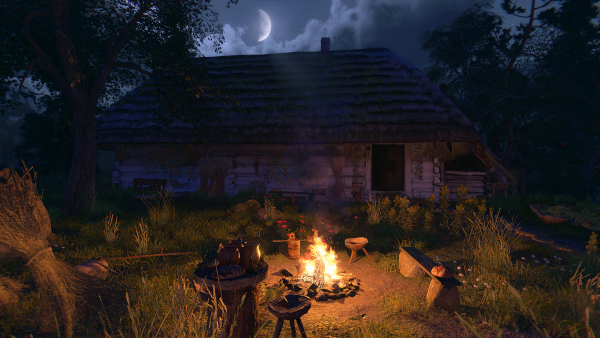
EM: You’re a small team in the middle of a Kickstarter effort, so let’s talk about that. Leading up to the crowdfunding launch, how have you managed the flow of information and interactions with the public, and how have current world events changed / accelerated your timetable? You’re based in Krakow, Poland, and I imagine the pace of life has shifted over the last few months; can you give a window in to your day and how the campaign fits in?
JM: To be honest, organizing that crowdfunding campaign and getting it to launch was one of the biggest difficulties of my career. There were small things, like the fact that Kickstarter is not available directly from Poland, so we needed to figure out how to launch with a global pandemic in the middle of our promotion, which was pretty stressful for us, because overall, many people who would like to support us sent messages that they are very sorry but they’ve lost their jobs because of pandemic. So it’s definitely been a hard time, but we just had no other option, so Kickstarter now, or develop The End of the Sun after hours working side jobs. Of course, there is also a publisher option, but that always contains hard terms, and we prefer to stay 100% indie; we are still open to publishers porting our game, for example, to consoles. We have been working a minimum of 12 hours per day (sometimes even 16), for the last 3 months, so this is an extremely hard time, especially because we do all the marketing and all the videos on our channel and music and sounds with very little help. So this is why we have a little ‘Hurray!’ on our team every time someone supports our project 🙂
In case you missed it, here’s the trailer:

